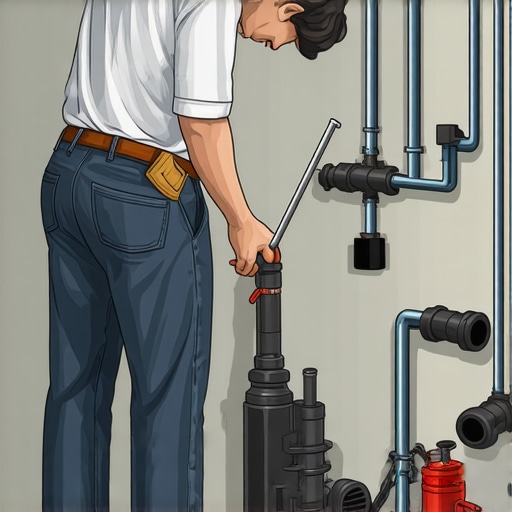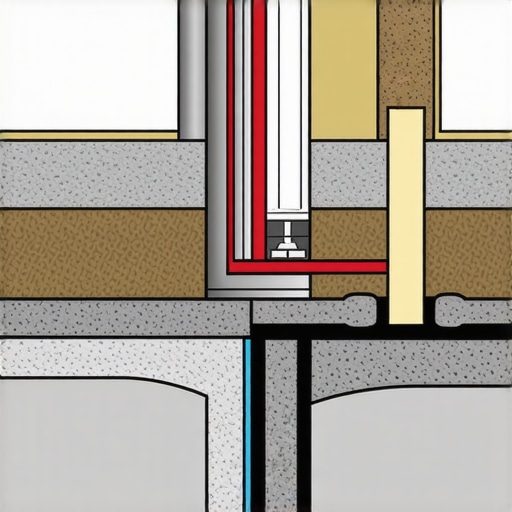My Journey to a Dry Basement: Installing a Sump Pump Was a Game Changer
Living in a region prone to heavy rains, I used to battle a damp, musty basement every year. It was frustrating, especially during spring storms. After researching extensively, I decided to install a sump pump myself, eager to take control of my home’s waterproofing. The process turned out to be more manageable than I expected and truly transformed my basement environment.
Understanding the Importance of a Proper Sump Pump System
Before diving into the installation, I learned that a sump pump is essential for preventing basement flooding and water damage. It works by removing excess water from the sump basin and directing it away from the house foundation. According to experts from DIY Kutak, a well-installed sump pump can save thousands in future repairs, making it a worthwhile investment for any homeowner.
Step-by-Step: How I Installed My Sump Pump
What Are the Key Considerations Before Installation?
Firstly, I assessed my basement to determine the best location for the sump basin—ideally the lowest point where water naturally accumulates. I also checked local codes and regulations, ensuring my installation would be compliant and safe. My research helped me choose a reliable sump pump model with sufficient capacity, considering factors like the size of my basement and average water flow.
The Practical Side of Installing a Sump Pump
Once I had my equipment, I dug a hole about 2-3 feet deep, following guidelines from DIY Projects for Beginners. I lined it with gravel for proper drainage, placed the sump basin, and connected the pump’s discharge pipe to a secure outdoor outlet. Sealing the lid tightly was crucial to prevent debris from clogging the system. The entire process was straightforward with the right tools and patience.
Why Should Every Homeowner Consider a DIY Approach?
In my experience, installing a sump pump myself not only saved money but also gave me a sense of accomplishment. If you’re comfortable with basic DIY tasks, you can follow detailed guides available at DIY Kutak. Plus, understanding your home’s water management system offers peace of mind, especially during unpredictable weather.
Ever Wondered About the Long-Term Benefits?
Beyond immediate waterproofing, a sump pump can extend the life of your basement, prevent mold growth, and protect your belongings. Regular maintenance, like inspecting the float switch and cleaning the basin, ensures optimal performance. I recommend checking out Home Improvement Tips for more handy DIY solutions that complement sump pump installation.
If you’ve ever faced basement flooding or are considering waterproofing your home, I encourage you to share your experiences or ask questions in the comments below. Together, we can master the art of home waterproofing and keep our homes dry and safe!
Mastering the Art of DIY Home Water Management: Advanced Tips and Tricks
Building on my previous experience with sump pump installation, I want to delve deeper into optimizing your home’s water management system. From selecting the right equipment to troubleshooting common issues, understanding these nuances can save you time and money in the long run. A comprehensive approach ensures your basement remains dry, resilient, and free from mold and water damage.
How Do You Choose the Perfect Sump Pump for Your Home?
Choosing the right sump pump involves assessing your specific needs—consider the size of your basement, water table levels, and the typical volume of water you expect to manage. Experts recommend opting for a pump with a capacity that exceeds your average water inflow to prevent system overloads during heavy rains. Additionally, features like a battery backup are crucial for continued operation during power outages, which are often coincident with severe storms. For detailed guidance, visit DIY Kutak.
Can Advanced Drainage Techniques Boost Your Waterproofing?
Beyond the sump pump, integrating advanced drainage solutions such as French drains or exterior waterproofing membranes can significantly enhance your system’s effectiveness. French drains, for example, channel water away from your foundation, reducing the load on your sump pump. Properly grading your yard to direct water flow away from your house is another critical step. Combining these techniques creates a multi-layered defense against water intrusion, which is especially vital in areas with high water tables or unpredictable weather patterns. For more insights, explore DIY Projects for Beginners.
What Are the Common Pitfalls and How Can You Avoid Them?
One of the most frequent mistakes is neglecting regular maintenance—like cleaning the sump basin or inspecting the float switch. Debris buildup can impede pump operation, leading to failures during critical moments. Also, improper discharge pipe installation can cause water to flow back into the basement, defeating the purpose of the system. Ensuring the discharge pipe slopes away from the foundation and is free of obstructions is essential. To keep your system in top shape, consider routine checks and professional inspections if needed. For detailed maintenance tips, see Home Improvement Tips.

Have you upgraded your water management system recently? Share your experiences or ask questions in the comments below. Also, if you’re interested in other DIY home improvement projects, don’t miss our guide on building step-by-step DIY guides for all skill levels—empowering you to tackle projects confidently and efficiently.
Reflections on My Waterproofing Journey: Beyond Basic Sump Pump Installation
As I delved deeper into the intricacies of home waterproofing, I realized that achieving a truly dry basement requires more than just installing a sump pump. It’s a complex, layered process that involves understanding your land’s unique geology, water flow patterns, and the subtle signs your home gives when water intrusion begins. My experience has taught me that ongoing education and proactive maintenance are vital—much like tending to a garden that needs regular care to thrive.
How Do You Balance DIY Enthusiasm with Professional Insight?
While I started with a DIY mindset, I soon discovered that some issues—like assessing the permeability of soil or installing exterior waterproof membranes—benefit from professional expertise. Consulting specialists or engineers can provide insights that save time and prevent costly mistakes. For example, understanding the specific drainage needs of your property might involve soil testing, which I initially overlooked. This experience underscored the importance of blending DIY effort with expert advice—creating a partnership that enhances your home’s resilience.
Personal Tips for Long-Term Waterproofing Success
In my journey, I found that routine inspections and thoughtful upgrades are key. Regularly checking the discharge pipe for obstructions, inspecting the sump basin for debris buildup, and ensuring the exterior grading directs water away from your foundation are tasks that pay dividends. I also learned the value of integrating advanced drainage solutions like exterior French drains or waterproof membranes, especially in areas with high water tables. These techniques, supported by detailed guides at DIY Projects for Beginners, can transform a basic system into a comprehensive water management network.
What Are the Hidden Challenges in Waterproofing?
One subtle challenge I encountered was detecting early signs of seepage before it became a major problem. Small cracks in the foundation or minor efflorescence on walls often go unnoticed. Using moisture meters or infrared cameras can reveal hidden issues that warrant attention. Additionally, I learned that climate variability—like unexpected heavy rains or rapid snowmelt—can stress even well-designed systems. Planning for these variables involves installing backup power sources for sump pumps and designing flexible drainage pathways.

If you’re like me, passionate about DIY and eager to safeguard your home, I invite you to share your experiences or ask questions in the comments. Exploring advanced techniques or personal stories can inspire others to take informed action. For more insights into creating resilient homes, check out Home Improvement Tips. Together, we can build smarter, stronger defenses against water intrusion and keep our basements dry year-round.
Leveraging Soil and Geology Insights to Strengthen Your Waterproofing Strategy
Deepening my understanding of my land’s geological profile, I discovered that soil composition and water permeability significantly influence waterproofing outcomes. Consulting geotechnical reports from experts like USGS revealed that areas with high clay content demand tailored drainage solutions, such as installing exterior membranes combined with French drains. Integrating this knowledge, I reinforced my system with exterior waterproof barriers, reducing hydrostatic pressure on my foundation and improving overall resilience.
How Can You Integrate Smart Monitoring for Proactive Water Management?
Implementing smart technology to monitor basement moisture levels can preempt costly repairs. IoT sensors, connected via a dedicated home automation system, provide real-time alerts when humidity or water ingress exceeds thresholds. This proactive approach allows for immediate intervention, such as activating backup sump pumps or inspecting drainage pathways. My experience with these innovations has been transformative, offering peace of mind and extending the lifespan of my waterproofing investments. For insights into integrating smart home solutions, explore Smart DIY Innovations.
What Are the Nuances of Maintaining a Complex Drainage System?
Beyond basic maintenance, managing an advanced drainage setup involves understanding flow dynamics and potential blockages. Regularly inspecting French drain perforations, ensuring gravel beds remain free of silt, and checking for root intrusion are critical steps. Using high-resolution infrared cameras, I identified concealed moisture pathways that could indicate failed seals or shifting soil. This meticulous approach allows me to address issues early before they escalate, safeguarding my basement from unforeseen water intrusion. To learn more about sophisticated drainage maintenance, visit Home Improvement Tips.

Engaging with these advanced strategies has elevated my waterproofing efforts from basic installation to a comprehensive, resilient system. If you’re committed to safeguarding your home against water damage and eager to explore these sophisticated techniques, I invite you to share your experiences or ask questions. Together, we can deepen our expertise and build homes that stand strong against the elements.
Things I Wish I Knew Earlier (or You Might Find Surprising)
Hidden Costs of DIY Projects
When I first started waterproofing my basement, I underestimated the hidden costs involved, like specialized tools and unexpected repairs. Looking back, budgeting for these extras from the start would have saved me some stress and money.
The Importance of Soil Testing
I learned the hard way that understanding your land’s geology is crucial. Soil testing revealed whether you need exterior waterproofing or additional drainage solutions, which saved me from costly mistakes later on.
Regular Maintenance Matters
Installing a sump pump isn’t a one-and-done deal. Regular inspections, cleaning, and testing are vital to keep everything running smoothly. Skipping maintenance can lead to system failures during critical moments.
Combining Techniques Creates Better Results
Relying solely on a sump pump isn’t enough. I found that combining it with French drains and exterior waterproof membranes provides a much more resilient waterproofing system. It’s like building a multi-layered defense for your home.
Power Outages Can Be a Weak Link
During storms, power outages are common, which can render your sump pump useless. Investing in a battery backup or generator is a game-changer, ensuring your basement stays dry even when the power goes out.
Resources I’ve Come to Trust Over Time
- USGS (United States Geological Survey): Their geotechnical reports helped me understand soil types and how they impact waterproofing. I highly recommend checking their resources for soil insights.
- DIY Kutak: This site offers step-by-step guides that boosted my confidence in tackling DIY waterproofing projects. It’s a goldmine for all skill levels.
- Home Improvement Tips: Regular maintenance tips and advanced DIY techniques from this site kept my system in top shape and prevented many issues.
Parting Thoughts from My Perspective
My journey into DIY basement waterproofing taught me that patience, proper planning, and ongoing maintenance are key. Installing a sump pump was just the start; combining it with other techniques and understanding your land’s geology makes all the difference. If you’re considering waterproofing your home, remember that a little extra research and preparation go a long way. I’d love to hear your stories or questions—feel free to drop a comment below or share this with someone who might find it helpful. Together, we can keep our homes dry and resilient against the elements!
